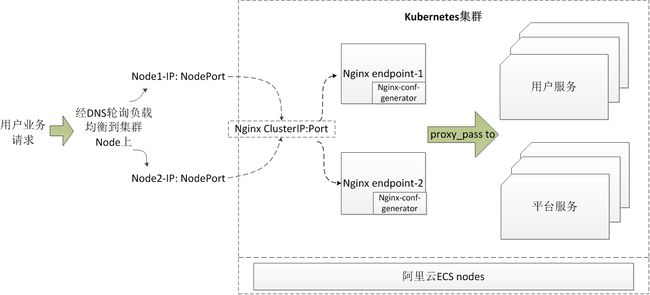【APP】为Kubernetes集群中服务部署Nginx入口服务
这段日子,一直在搞与Kubernetes有关的东东:像什么Kubernetes集群搭建、DNS插件安装和配置、集成Ceph RBD持久卷、Private Registry镜像库访问等,这些都缘于正在开发的一个类PaaS小平台的需要:“平台虽小,五脏俱全”。整个平台由Kubernetes集群承载,对于K8s集群内部的Service来说,目前还欠缺一个服务入口。之前的《Kubernetes集群中的Nginx配置热更新方案》一文实际上就是入口方案设计的一个前奏,而本文则是说明一下Nginx入口服务部署设计和实施过程中遇到的一些坑。
一、Nginx入口方案简述
Nginx作为集群入口服务,从功能上说,一般都是充当反向代理和负载均衡的角色。在我们这里它更多是用于反向代理,因为负载均衡的事情“移交”给了K8s去实现了。k8s通过ClusterIP- 一种VIP机制,默认基于iptables的负载分担实现服务请求的负载均衡(如iptable nat table的规则:-m statistic –mode random –probability 0.33332999982),查看iptables nat链的rules,可以看到如下样例:
# iptables -t nat -nL
... ...
Chain KUBE-SVC-UQG6736T32JE3S7H (2 references)
target prot opt source destination
KUBE-SEP-Z7UQLD332S673VAF all -- 0.0.0.0/0 0.0.0.0/0 /* default/nginx-kit: */ statistic mode random probability 0.50000000000
KUBE-SEP-TWOIACCAJCPK3HWO all -- 0.0.0.0/0 0.0.0.0/0 /* default/nginx-kit: */
... ..
接下来,我们简单说说我们的Nginx入口方案。事先声明:这绝对不是一个理想的方案,因为它还有诸多缺陷,只是在目前平台需求上下文和资源的约束前提下,它可以作为我们的一个可用的过渡方案,方案示意图如下:
- Nginx以Kubernetes service的形式运行于K8s cluster内部,并限制只能被K8s调度到带有label: role=entry的Node上;
- 最外层,通过DNS域名的轮询机制,实现用户请求在Node这一层上的“负载均衡”;
- 访问某个NodeIP:NodePort的请求,被转发到Nginx ClusterIP: Port,并通过iptables nat的负载机制,分发到Nginx service的多个real endpoints上;
- 位于real endpoint上的Nginx程序处理用户请求,并根据配置,将请求proxy_pass到后端服务的ClusterIP:Port上,并最终由k8s实现将请求均衡分发到后端服务的endpoint。
二、Nginx入口服务部署
部署前,我们先来给运行Nginx Pod的Node打label:
# kubectl label node/10.47.136.60 role=entry
node "10.47.136.60" labeled
# kubectl label node/10.47.136.60 role=entry
node "10.47.136.60" labeled
# kubectl get nodes --show-labels
NAME STATUS AGE LABELS
10.46.181.146 Ready 39d beta.kubernetes.io/arch=amd64,beta.kubernetes.io/os=linux,kubernetes.io/hostname=10.46.181.146,role=entry,zone=ceph
10.47.136.60 Ready 39d beta.kubernetes.io/arch=amd64,beta.kubernetes.io/os=linux,kubernetes.io/hostname=10.47.136.60,role=entry,zone=ceph
在Nginx配置热加载方案一文中,我们提到一个nginx pod中包含三个Container:nginx、nginx-conf-generator和init container,Nginx service的yaml示例如下:
//nginx-kit.yaml
apiVersion: extensions/v1beta1
kind: Deployment
metadata:
name: nginx-kit
spec:
replicas: 2
template:
metadata:
labels:
run: nginx-kit
annotations:
pod.beta.kubernetes.io/init-containers: '[
{
"name": "nginx-kit-init-container",
"image": "registry.cn-beijing.aliyuncs.com/xxxx/nginx-conf-generator",
"imagePullPolicy": "IfNotPresent",
"command": ["/root/conf-generator/nginx-conf-gen", "-mode", "gen-once"],
"volumeMounts": [
{
"name": "conf-volume",
"mountPath": "/etc/nginx/conf.d"
}
]
}
]'
spec:
containers:
- name: nginx-conf-generator
volumeMounts:
- mountPath: /etc/nginx/conf.d
name: conf-volume
image: registry.cn-beijing.aliyuncs.com/xxxx/nginx-conf-generator:latest
imagePullPolicy: IfNotPresent
- name: xxxx-nginx
volumeMounts:
- mountPath: /etc/nginx/conf.d
name: conf-volume
image: registry.cn-hangzhou.aliyuncs.com/xxxx/nginx:latest
imagePullPolicy: IfNotPresent
command: ["/home/auto-reload-nginx.sh"]
ports:
- containerPort: 80
volumes:
- name: conf-volume
emptyDir: {}
nodeSelector:
role: entry
---
apiVersion: v1
kind: Service
metadata:
name: nginx-kit
labels:
run: nginx-kit
spec:
type: NodePort
ports:
- port: 80
nodePort: 28888
protocol: TCP
selector:
run: nginx-kit
关于这个yaml,有几点我们是必须要说说的:
1、关于init container
通过上述yaml文件内容,我们可以看到init container和nginx-conf-generator container都是基于同一镜像创建的,只是工作mode不同罢了。在deployment描述文件中,init container的描述需要放在deployment.spec.template.metadata下面,而不是deployment的metadata下面。如果按照后者编写,那么init container将不会被创建和启动,nginx container启动后也就会提示:找不到”default.conf”。
另外,虽然源自同一个image,但init container启动时却提示在$PATH里找不到名为”-mode”的可执行程序,显然init container中的ENTRYPOINT并不起作用,nginx-conf-generator的Dockerfile节选如下:
//Dockerfile
From ubuntu:14.04
... ...
ENTRYPOINT ["/root/conf-generator/nginx-conf-gen"]
为此我们在init container的”command”命令参数中增加了可执行程序全路径以供container执行:
"command" : ["/root/conf-generator/nginx-conf-gen", "-mode", "gen-once"],
最后,通过上面yaml文件创建nginx-kit服务依旧要用kubectl apply,而不是kubectl create,否则init container不会被理会。
2、关于nginx conf模板
由于种种原因,当前我们是通过server host的location path来映射后端cluster中的不同Service的,nginx default.conf模板如下:
server {
listen 80;
#server_name opp.neusoft.com;
{{range .}}
location {{.Path}} {
proxy_pass http://{{.ClusterIP}}:{{.Port}}/;
proxy_redirect off;
proxy_set_header Host $host;
proxy_set_header X-Real-IP $remote_addr;
proxy_set_header X-Forwarded-For $proxy_add_x_forwarded_for;
}
{{end}}
#error_page 404 /404.html;
# redirect server error pages to the static page /50x.html
#
error_page 500 502 503 504 /50x.html;
location = /50x.html {
root /usr/share/nginx/html;
}
}
这里要注意的是proxy_pass directive后面值的写法,如果你选择这样写:
proxy_pass http://{{.ClusterIP}}:{{.Port}};
那么当访问某个路径时,比如:localhost/volume/api/v1/pools时,nginx后端的Service收到的url访问路径将是:/volume/api/v1/pools,volume这个location path并不能被去除,后端的Service在做路由匹配时基本都是会出错的。fix的方法是赋予proxy_pass directive下面这样的值:
proxy_pass http://{{.ClusterIP}}:{{.Port}}/;
没错,在最后加上一个”/”,这样nginx所反向代理的Service将会收到/api/v1/pools这样的访问URl路径。
© 2016~2018, Enweitech. 版权所有.
